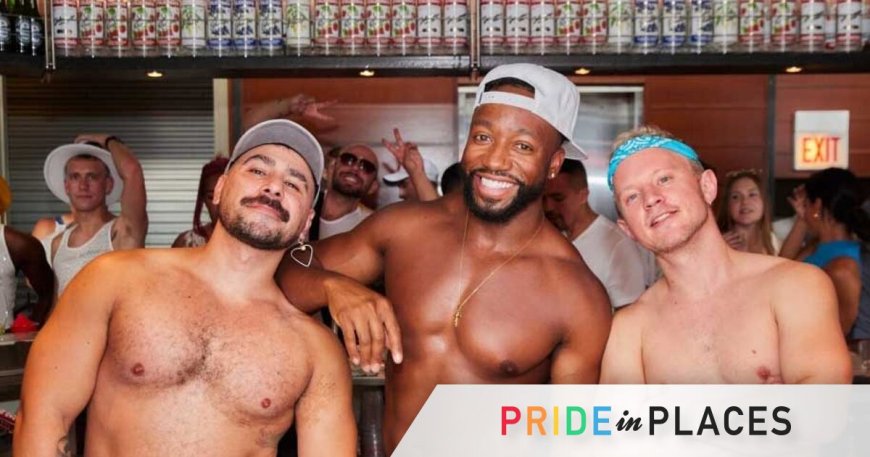Pride in Places: How this nightclub evolved from a hole-in-the-wall into a massive enterprise
It's thanks to gay bars like Sidetrack and neighboring Closet and Roscoe's Tavern for bringing Chicago's gayborhood to fruition.


When Sidetrack first began serving Chicago‘s queer community in 1982, it was expected to fail like most gay bars opening at that time, an era rampant with homophobia. The majority lasted less than two years.
Business (and life) partners Art Johnston and Pepe Peña founded the venue as an 800-square-foot storefront without front-facing windows. Their business was signless and used beer casings as seating. But their humble beginnings didn’t happen without big ambitions.
Two years later, the owners expanded Sidetrack to double the size. In 1898, they opened the first version of Backbar, then in 1994, CherryBar popped up overlooking MainBar. They hung a small sign on Halsted Street.

General manager Bryan Smith, who has worked there since 2001, tells GayCities the bar continued gradually building on itself to achieve its current nightlife glory. Not to mention absorbing its surrounding premises, eventually spanning more than eight storefronts and multiple levels, a patio, and a roof deck that can host more than 1000 people.
As these initial renovations happened, it wouldn’t be until 1999 that the city of Chicago declared Sidetrack’s Boystown neighborhood the “official” gay village. Before the wonders of gentrification took place, the area was known for gangs and crime. Still, these factors posed less of a targetted risk to queer people, and they found refuge at Sidetrack from prejudice in law and society.

“Very little investment went into making [gay] bars look nice because it wasn’t expected that the businesses would last a long time,” says Smith, “Art and Pep really invested in the aesthetic of the space and purchasing the spaces around them as they became available.”
The general manager says Sidetrack’s metamorphosis aligned with the evolution of societal queerness and visibility. He says as gay foot traffic escalated in the neighborhood, the bar grew with the number of newcomers dropping by for a drink. They even experienced an influx of hetero people who felt comfortable – even excited – to come in and enjoy TimeOut and Buzzfeed’s best-rated gay bar in Chicago.

“We also have people that have been coming here since we opened, and they sat on beer boxes in that small space. But you also have people who are going to turn 21 tonight. We have quite a diverse crowd in gender expression, age, and sexuality.”
Sidetrack showed to the world that if you build it gayer, gayer people will come, and the longstanding anchor of the Halsted strip ushered a new era of grandiosity in queer nightlife, which used to be relegated to dive bars in the outskirts of society.
“We’re celebrating our 41st anniversary with a customer appreciation party tomorrow night. We’re at just over 17,000 square feet,” says Smith.

In 2021, Boystown was renamed “Northalsted” for inclusion, dividing the public between those desiring to preserve history and those feeling left out by it. Gay bars have popped up in Chicago by the dozens, the prime real estate being the zipcode that once was for outcasts.
Smith says Art and Pep believed in their community, and it was thanks to gay bars like Sidetrack and its neighboring the Closet and Roscoe’s Tavern that paved the way for the gayborhood to come to fruition. After all, as the gays know from experience, you must learn to see the beauty where people told you there was none to achieve progress and success.
In an interview with NBC Chicago, Peña said, “I believe that almost everything important in the history of the gay community began at a [gay] bar. Bars were the only places gay people could meet.”
But as far as business and love stories go, he says his romance happened before his partnership. He says there would have never been Sidetrack had he not gone on a first date with Art that lasted 49 years.
Aside from queer nightlife, the couple served as civil rights leaders. Their life and love were behind LGBTQ+ equality in the heartland, the first state to decriminalize homosexuality. You can see their journey as lovers and revolutionaries in the 2022 documentary ART AND PEP, streaming on Peacock.
Smith says it’s all tied together: the history of their relationship, the history of the LGBTQ movement in Chicago, and the history of Sidetrack.
Of course, many gay bar owners know what it’s like to be groundbreaking – and controversial – for putting your name to a lease and serving drinks. But every failed queer business was a stepping stone for those that succeeded, and ultimately, the transformation of entire community infrastructures and demographics.
Walking through Northhalsted today, you’ll be greeted with plenty of rainbows. However, Sidetrack’s evolution is indicative that you can’t move mountains, but two gay lovers can build their own if they’re patient and trust in the limitless potential of queerness. History shows that a small gay neighborhood pub today can be a contender for the best gay bar in the country tomorrow.


 Mark
Mark 





